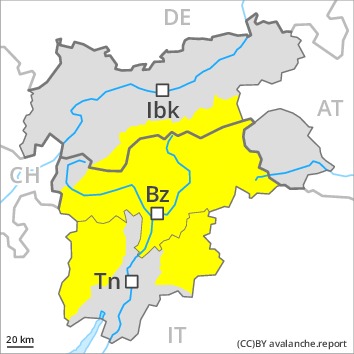
Danger level
Avalanche Problem
 | | Gliding snow |
|  | |  |
 | | Wind-drifted snow |
|  | |  |

As a consequence of warming during the day and solar radiation more gliding avalanches are possible. Wind slabs are to be evaluated with care and prudence.
As a consequence of warming individual gliding avalanches are possible, even medium-sized ones.
The fresh wind slabs are to be evaluated with care and prudence in particular on west to north to east facing aspects above the tree line. The number and size of avalanche prone locations will increase with altitude.
Ski touring calls for experience in the assessment of avalanche danger and careful route selection.
Snowpack
dp.2: gliding snow
The covering of new snow is fairly homogeneous and has a loosely bonded surface. Towards its base, the snowpack is wet, especially at low and intermediate altitudes. As a consequence of the moderate wind, snow drift accumulations formed during the last few days, in particular adjacent to ridgelines and in gullies and bowls. This applies above the tree line.
Tendency
The avalanche danger will persist.

Danger level
 | 2400m
|
Avalanche Problem
 | | Wind-drifted snow |
|  | |  |
 | | Gliding snow |
|  | |  |

Old wind slabs represent the main danger. Individual gliding avalanches can also occur.
The sometimes large wind slabs remain in some cases prone to triggering in particular on northwest to north to northeast facing aspects above approximately 2400 m. They can be released by large loads at their margins in particular. As a consequence of warming during the day and solar radiation dry and moist avalanches are possible as the day progresses.
On very steep grassy slopes and on sunny slopes only isolated gliding avalanches are possible, even quite large ones. Exposed parts of transportation routes can be endangered occasionally in the regions with a lot of snow. Caution is to be exercised in areas with glide cracks.
In isolated cases avalanches can be triggered in deep layers of the snowpack and reach quite a large size. This applies in case of releases originating from very steep starting zones at high altitudes and in high Alpine regions that have retained the snow thus far. Caution is to be exercised in particular at transitions from a shallow to a deep snowpack.
Snowpack
dp.2: gliding snow
Sunshine and high temperatures gave rise on Wednesday to moistening of the snowpack in particular on sunny slopes. More recent wind slabs are to be found in particular in gullies and bowls, and behind abrupt changes in the terrain. In some cases the various wind slabs have bonded poorly together. Faceted weak layers exist deep in the old snowpack especially at high altitudes and in high Alpine regions. This applies at high altitudes and in high Alpine regions. The snowpack is fairly homogeneous and its surface has a melt-freeze crust. This applies on sunny slopes below approximately 2500 m.
Tendency
The avalanche danger will persist. Individual gliding avalanches can also occur.












